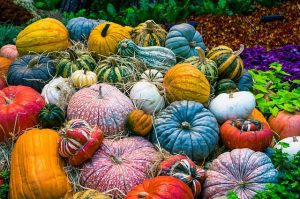Pumpkin Anatomy - Do you know the names of all the parts?
I decided to do a post on pumpkin anatomy since I like to educate everyone about my favorite Fall fruit! When you love pumpkins as much as I do you want to know everything about them!

Have you ever wondered what we call the different pumpkin parts?! Do you know what the top of a pumpkin is called or how about the bottom? Did you know the pumpkin has 2 different types of flowers? I hope I can answer all your queries!
To be honest the diagram above is a good guide and something you might want to print out to help you remember.
Pumpkin Anatomy - Part by Part
The diagram above will have shown you most of the different pumpkin parts, but of course there are always some more! I decided to divide this into different areas; growing pumpkin parts and then the actual pumpkin itself.
Anatomy of Growing Pumpkin Parts
Of course all these pumpkin parts are necessary for successful growth of your fruit. If one part rots or comes to harm you can kiss goodbye to your beautiful fruit.
Root - this is implanted in the soil and the method by which nutrients, fertilizer and water get to your growing pumpkin. If the roots are damaged your vine will not grow and you will have no fruit!
Vine - this is one of the most important parts of a growing pumpkin! It can grow extremely long, up to 30 feet and house several pumpkins; the number depends on the type. The vine is connected to the roots.
Leaves - cooked pumpkin leaves are full of flavour and nutrients! These pumpkin leaves help shade the soil from bright sunlight in peak Summer. Wilted leaves also help you to know when your pumpkin needs more water.
Stem -you might also question what color is a pumpkin stem. Well the stem is green initially and stays this color until the pumpkin is ripe; it then turns brown. We all love to see brown pumpkin stems as it means our glorious fruit is ready to eat. The stem can be found attached to the vine, which is attached to the root.
A common question is what is the stem of a pumpkin called. Pumpkin stem name is peduncle but most people just call it the stem or handle so do not be surprised if someone does not know what you mean if you use the correct anatomy of a pumpkin name.
Tendrils - these are thin green structures on the vine. Their main purpose is to help support the vine and prevent it from falling down in windy weather. They can wind around fences to secure the vine.
Female Pumpkin Flowers - these appear after the male flowers and require pollination for the fruit to develop and grow. If no pollination occurs no pumpkins will grow and the female pumpkin flowers will die!
Some people have asked me what part of the plant is a pumpkin? I guess I would say it is the part bearing fruit. The pumpkin fruit can be found on the vine of the plant.
Anatomy of Pumpkin Parts as you see it
The easier part that everyone knows is the skin, which covers the entire pumpkin. It is also known as the rind and is a very tough fibrous material, which we do not eat! I could not imagine trying to bite into it, I would probably crack a tooth!! It does look very pretty and comes in different colors depending on the type of pumpkin
The top of pumpkin is known as the lid! When we carve a pumpkin we cut this bit off!
The bottom of a pumpkin, where the hole is, is known as the blossom end.
Perhaps you will pay more attention to your pumpkin patch now and maybe even ask your kids to identify the different pumpkin parts. Of course these all appear at different times of the pumpkin life cycle.
How to help kids learn all Pumpkin Parts
How about using this as a kid's learning experience and using one of the printable worksheets I found by The Crafty Classroom. I think these are brilliant for Fall especially if you are Homeschooling but even if you are not, they still teach kids.
Why not watch as your pumpkins grow and see all the different parts of anatomy appearing along the way. Another great idea is to learn about the different types of pumpkins.





Leave a Reply